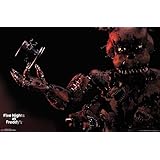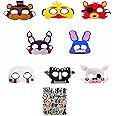Five Nights at Freddy’s (FNAF) is not just a simple horror video game series; it has grown into a cultural phenomenon since its initial release in 2014. As the franchise expanded, the visual elements, including the iconic signage, played a pivotal role in its branding and user experience. This article delves into the intricate design process behind the FNAF sign, exploring its evolution, significance, and the creative decisions that shaped it.
The Origins of Five Nights at Freddy’s

Before diving into the design of the sign, it’s essential to understand the context of the game itself. Created by Scott Cawthon, FNAF revolves around a haunted pizza restaurant, reminiscent of Chuck E. Cheese, where animatronics roam and pose a threat to the player. The game’s atmosphere combines nostalgia with horror, creating a unique blend that has captivated millions of players worldwide.
Initial Concept and Design Philosophy
Scott Cawthon’s initial design choices were primarily influenced by his experiences and the limitations of his resources. The FNAF sign is essential in establishing the tone of the game, serving as a visual gateway into the eerie world of Freddy Fazbear’s Pizza. Here’s a breakdown of the design philosophy:
- Nostalgic Elements: The sign incorporates retro aesthetics reminiscent of 1990s family entertainment venues.
- Color Palette: A bright yet unsettling color scheme is used to evoke feelings of both joy and dread.
- Typographic Choices: The font used is playful yet slightly chaotic, emphasizing the juxtaposition of fun and danger.
The Importance of Signage in Game Design
In video games, signage serves several crucial functions:
- Brand Identity: A well-designed sign can enhance brand recognition and loyalty.
- Atmosphere Setting: The sign sets the tone for the game, preparing players for what lies ahead.
- Visual Storytelling: Elements in the sign can hint at the game’s lore and backstory.
The FNAF sign accomplishes all of these functions, acting as a beacon that lures players into its horror-filled narrative.
The Design Process: From Concept to Creation
The journey from initial concept to the final design of the FNAF sign involved multiple stages, each critical to ensuring that the sign accurately reflected the game’s themes and atmosphere.
1. Ideation and Sketching

The design process often begins with brainstorming sessions and sketching. Cawthon initially created rough sketches that encapsulated his vision:
- Exploring various shapes and sizes for the sign.
- Experimenting with different fonts and colors.
- Considering how the sign would fit into the broader design of the game.
During this phase, Cawthon would often gather feedback from peers and fans to refine his ideas.
2. Digitalization and Prototyping
Once the sketches were finalized, the next step involved digitalizing the artwork. This phase included:
- Using graphic design software to create a digital version of the sign.
- Testing various color combinations and textures to find the most striking visual impact.
- Creating prototypes to visualize how the sign would look in-game.
Digitalization allowed for a more precise representation of colors and shapes, essential for the atmospheric feel of the game.
3. Feedback and Iteration

The design process is rarely linear. Following the prototyping phase, Cawthon sought feedback from trusted sources, which led to several iterations:
- Adjusting the color contrasts for better visibility.
- Refining the typography to make it more legible.
- Incorporating elements that hint at the animatronics’ presence and the restaurant’s dark past.
Iterating based on feedback ensured that the final design resonated with the target audience while being coherent with the game’s themes.
Case Study: The FNAF Sign in Context

The FNAF sign serves as a perfect case study for how signage can impact a video game’s success. Examining its placement and design within the game reveals deeper insights:
Setting the Scene

The sign appears prominently in the game’s opening sequences, establishing the setting for players. Its design aligns with the following aspects:
- Atmospheric Consistency: The sign’s colors and font match the game’s overall aesthetic, creating a cohesive experience.
- Foreshadowing: Subtle details in the sign hint at the dark lore of Freddy Fazbear’s Pizza, enhancing the narrative.
- Engagement: Players are immediately drawn in, their curiosity piqued by the playful yet ominous vibe.
Impact on Player Experience
Research indicates that well-designed signage can significantly enhance user experience in gaming:
- According to a study by the Game User Experience group, players are more likely to feel immersed in a game with cohesive design elements.
- Signage can influence emotional responses, as seen with the FNAF sign, where players experience a mix of nostalgia and fear.
The FNAF sign successfully amplifies the psychological aspects of horror, playing a critical role in player engagement.
Conclusion: The Legacy of the FNAF Sign

The design process behind the Five Nights at Freddy’s sign is a testament to the power of thoughtful design in video games. From its nostalgic roots to its chilling execution, the sign encapsulates the essence of the franchise. By understanding the intricacies of its design—from ideation through to final iteration—we gain insights into how visual elements can shape a player’s experience.
As the FNAF franchise continues to evolve, the sign remains a powerful symbol of its identity, proving that effective design can leave a lasting impact in the world of gaming. As designers and creators, we can take inspiration from Cawthon’s process, recognizing the importance of feedback, iteration, and cohesive design in crafting memorable experiences.


